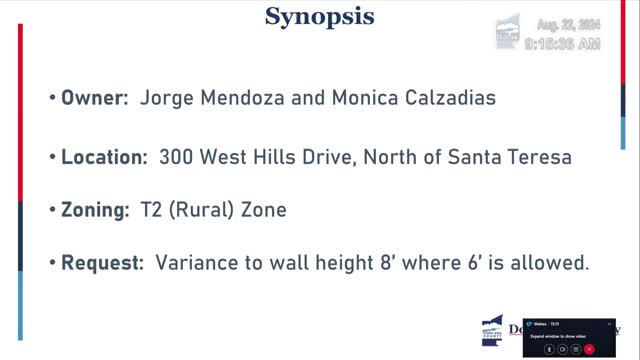Homeowner Battles Neighbors Over Safety and Code Violations
August 23, 2024 | Doña Ana County, New Mexico
This article was created by AI summarizing key points discussed. AI makes mistakes, so for full details and context, please refer to the video of the full meeting. Please report any errors so we can fix them. Report an error »

In a recent government meeting, a proposal for a variance regarding a residential property in Santa Teresa was discussed, focusing on the construction of an eight-foot rock wall intended to enhance safety for the applicant's family. The property, a 2.5-acre parcel located in a rural zone, has faced numerous challenges, including aggressive dogs from neighboring properties and concerns about wildlife, particularly coyotes.
The applicant, who purchased the property in 2015, initially erected a six-foot chain link fence to mitigate issues with trash and debris from neighboring lots. However, the fence proved inadequate as unrestrained dogs dug under it, prompting the applicant to reinforce it with wooden planks and eventually opt for a higher rock wall. The applicant expressed concerns for the safety of their young children, citing incidents involving aggressive dogs and wildlife threats, including the loss of a pet dog to a coyote.
During the meeting, it was revealed that the property had been littered with trash from neighboring lots, and there were ongoing issues with a neighbor burning debris, raising fire safety concerns. The applicant reported multiple visits from the sheriff's department due to shots fired in the area, further emphasizing the need for enhanced security measures.
Public notifications regarding the variance request were sent out, and no opposition was recorded. The planning staff recommended conditional approval of the variance, noting that the height of the wall would not be detrimental to public health or safety and would provide necessary protection for the applicant's family.
The applicant acknowledged a lack of awareness regarding the need for building permits, as they had previously worked in a jurisdiction where such permits were not required. They have since submitted engineered drawings for the rock wall and other structures on the property, agreeing to comply with local building codes and pay associated fees.
The commission ultimately voted in favor of granting the variance, allowing the construction of the rock wall while ensuring compliance with safety and building regulations. The decision reflects a broader concern for residential safety in rural areas, particularly in light of increasing incidents involving aggressive animals and environmental hazards.
The applicant, who purchased the property in 2015, initially erected a six-foot chain link fence to mitigate issues with trash and debris from neighboring lots. However, the fence proved inadequate as unrestrained dogs dug under it, prompting the applicant to reinforce it with wooden planks and eventually opt for a higher rock wall. The applicant expressed concerns for the safety of their young children, citing incidents involving aggressive dogs and wildlife threats, including the loss of a pet dog to a coyote.
During the meeting, it was revealed that the property had been littered with trash from neighboring lots, and there were ongoing issues with a neighbor burning debris, raising fire safety concerns. The applicant reported multiple visits from the sheriff's department due to shots fired in the area, further emphasizing the need for enhanced security measures.
Public notifications regarding the variance request were sent out, and no opposition was recorded. The planning staff recommended conditional approval of the variance, noting that the height of the wall would not be detrimental to public health or safety and would provide necessary protection for the applicant's family.
The applicant acknowledged a lack of awareness regarding the need for building permits, as they had previously worked in a jurisdiction where such permits were not required. They have since submitted engineered drawings for the rock wall and other structures on the property, agreeing to comply with local building codes and pay associated fees.
The commission ultimately voted in favor of granting the variance, allowing the construction of the rock wall while ensuring compliance with safety and building regulations. The decision reflects a broader concern for residential safety in rural areas, particularly in light of increasing incidents involving aggressive animals and environmental hazards.
View full meeting
This article is based on a recent meeting—watch the full video and explore the complete transcript for deeper insights into the discussion.
View full meeting
